A Filmmaker's Guide to the Horror Techniques Used in 'The Sixth Sense'
Study, Analysis, and Experience
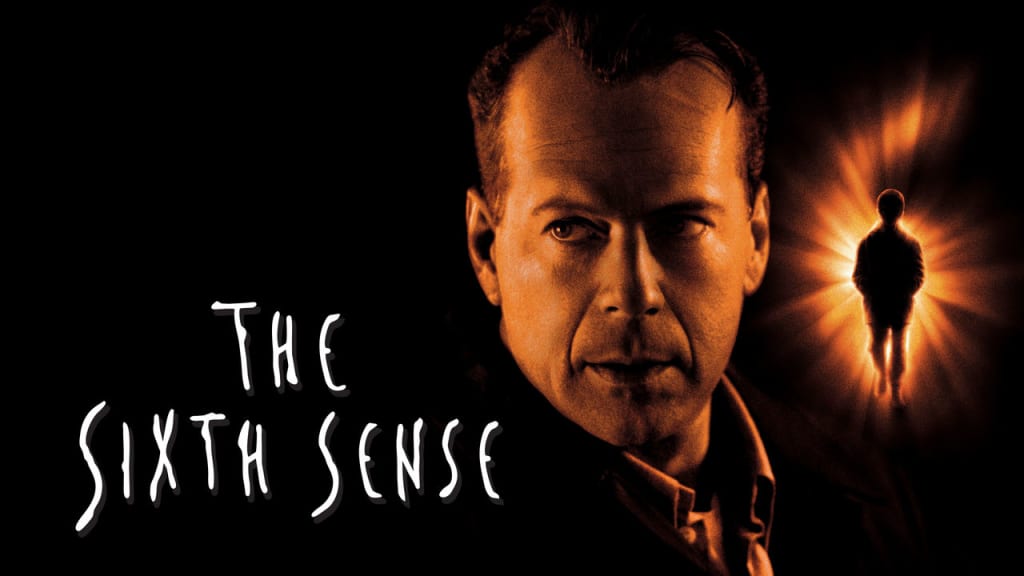
(Note: this article will contain analysis on the film The Sixth Sense and in order to get the best insight, it is recommended you watch the entire film at least once).
The Sixth Sense is well known as one of the greatest horror/thriller films ever created. There are many, many themes that are used to add to the experience of the film and, of course, one of the greatest movie twists ever filmed. We're going to look at three of the main themes that are used and they are:
- Death
- Darkness
- Temperature
Let's begin and study how this film creates a great atmosphere that adds to the overall impact of the film.
1. Death
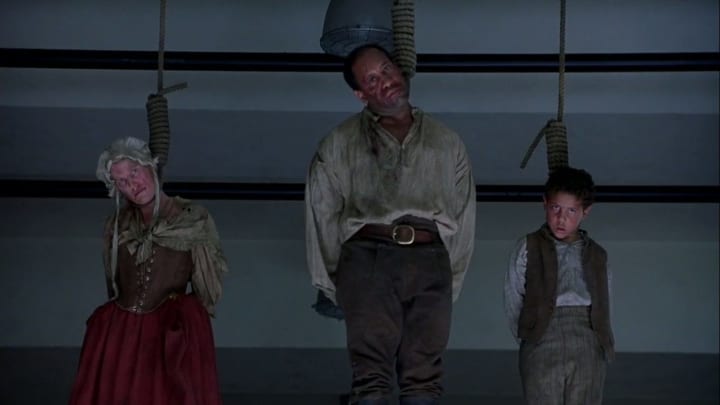
A Still from "The Sixth Sense"
Death in The Sixth Sense is possibly the biggest and most expansively explored theme because of how much it effects most every character in the film. This humanises everything because of the fact that each character is going through their own grieving process and therefore, are vulnerable to the events that take place.
Let's take a look at this frame then. In this frame we see the dead people that Cole also sees hanging by the neck until dead. The great thing about seeing what Cole is seeing is that nobody else sees it. The filmmaker always has one POV shot in which there are no dead people and then, Cole's POV shot in which there are dead people. It allows us to experience what Cole is experiencing and, in most cases it turns out to either be very saddening or quite frightening.
Notice how these people are dressed. They are not from the modern day and so, this tells us exactly what Cole sees; he can see dead people from a long time ago as well as the ones from today. This means that for this young boy, death is just about everywhere.
The most noticeable thing about this frame though is where they are. Cole seems to be at school, which not only tells us that he cannot control what he sees but it also gives a background as to what his school was in the time at which these people died. For a children's elementary school, this can be considered quite disturbing and therefore, death creates horror.
Let's take a look at another frame:
Frame 1
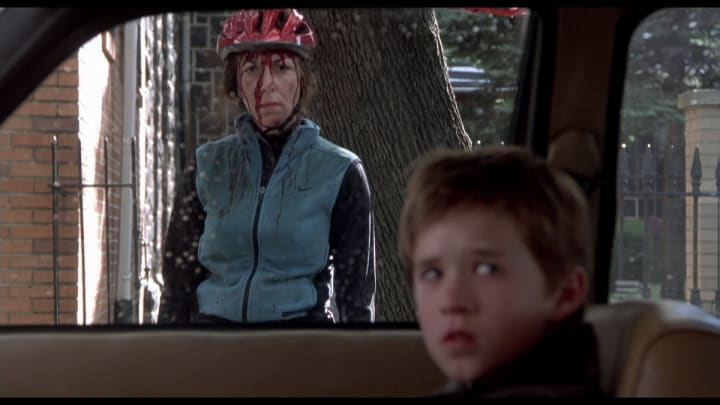
A Still from"The Sixth Sense"
The first thing we notice about this frame is obviously the woman with her face covered in blood. This is when Cole tells his mother about what's happening and she believes him. This scene creates horror as it does the exact same thing; in conversation we don't see what Cole sees because of the normal POV shot from the mother and only when Cole says, "she's standing outside my window," do we see what Cole was looking at when he looked out of the window.
The next thing we are meant to notice is the fact that the lady is not looking at Cole, despite Cole being the only one who can see her. She's actually looking at the mother as if asking her to believe Cole even though the mother cannot see her. This is highly effective for the mother's POV shot in which we see what Cole is seeing. It is suggestive of her believing him because we see what Cole sees without having to be in his POV and with the dead woman now standing at the window, we nor the mother have a choice but to believe him.
Let's now take a look at the final frame of this theme:
Frame 2
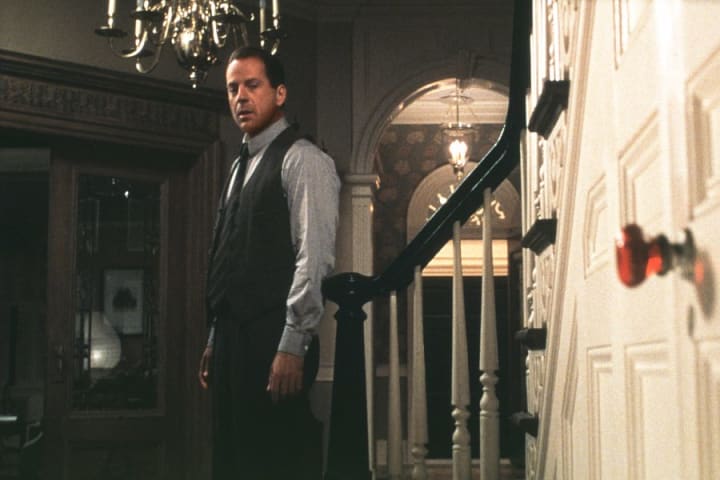
A Still from "The Sixth Sense"
In this frame we see the Doctor in the "twist ending" scene in which, after this, he attempts to open the door. This only happens when he's finished helping Cole and then we get the flashbacks on to what Cole had been saying about dead people not finishing what they started and coming back in order to do so. We find out that Malcolm is, in fact, dead.
This frame is incredibly suggestive of the reality he had believed to be one in which he is alive. The first thing we have is the image of the door, we purposefully cannot see if there is anything in front of it because at this moment, we see what the Doctor sees. It's only when he goes to open the door does he realise that it doesn't open.
There are also things in this scene that suggest that the Doctor only sees what he wants to see. The fact that nearly all the lights are on but the woman on the chair is asleep is heavily suggestive as we never find out whether she turned the lights on and fell asleep (which seems unlikely) or if he's imagining that the lights are on and they aren't.
The clothing that the Doctor is in are pretty much the same clothes he wears throughout most of the film and yet, nobody tends to realise that this film takes place over a very long time. The clothes are the same ones he died in.
2. Darkness

A Still from "The Sixth Sense"
In The Sixth Sense the theme of darkness exemplifies a lot of things. It exemplifies atmosphere, the false sense of danger and even the way in which the story is told. Let's have a look how that happens in this frame to begin with:
The atmosphere of this frame is exemplified by the fact that there is only one, small light source and it is held by the main character. He's sitting on the ground looking at figurines he's stolen from the church. What we have here is the sense of security through worship— much like the scenes in other films that have exorcisms, these religious statuettes seem to make the bad demons go away. The atmosphere is darkened by the light source flooding this small space with shadows.
Here's a tip: if you want to create darkness with a light source in a small space, then use a focused light source as it will give shadow to a lot of the scene and make it seem a lot darker than it actually is.
Let's have a look at the next frame:
Frame 3

A Still from "The Sixth Sense"
This frame elicits a false sense of danger through the way it presents darkness. The child appears from under the bed and slides a video tape she had secretly recorded over to Cole.
The fact that the girl is dead means that she would look pale and have darkened circles around her eyes. Which is true, she does have those features. There is nearly no light source in this scene and by the dark colour of her hair and her eyes, there is a sense of danger from when she appears in a dark area. Even though Cole is not in any danger, the frame creates one by having it happen so suddenly and having the very young girl look quite threatening; but it is clear that Cole is in no danger at all by the fact that after the handing over the video tape there is not much else seen.
The clever thing about this scene is that if you were to look slightly behind the girl on your right, you will see that there is a cross in the background, harkening back to that scene with the tent in which Cole feels safe. This illusion of danger is watched over by a gratifying sense of safety and therefore, there is nothing that Cole should be afraid of in this room.
Frame 4
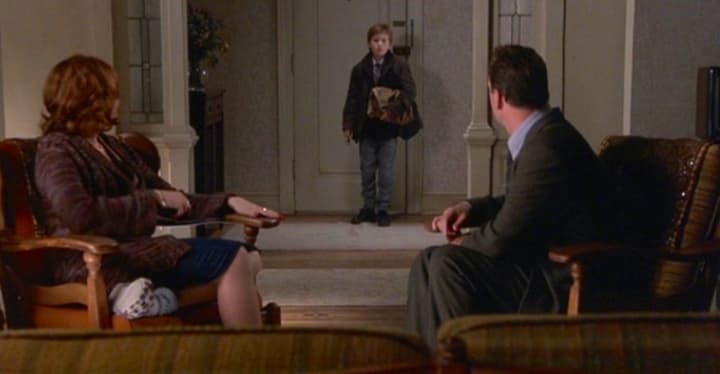
A Still from "The Sixth Sense"
Darkness and shadow in this frame are of high importance. Look at where Cole is standing compared to where the Doctor and his mother are sitting. Cole is not lit by any light source except for the small amount that part of the frame gets from the light source in the main room. The significance of putting him in that dark space is to show how this Doctor is helping him and how he is helping this Doctor.
In this scene, he moves towards the lighter space and his shadows increase; thus showing that he must confront whatever he has and this Doctor will eventually do what he set out to do.
If you look at where the mother and the Doctor are placed. They are placed cleverly so that as Cole moves forwards, it doesn't look as if he's going towards any one person because, remember, the mother cannot see the Doctor.
3. Temperature

A Still from "The Sixth Sense"
Temperature has a lot of importance in The Sixth Sense and, even though it uses that classic horror-film blue-tint, it isn't overused so that it gives a hue to the scene. Instead, it's created using natural, artificial, and shadowing lights. It gives not really a blue tint, but a blueish-grey tint and this not only gives the feel of darkness in the scene, but it also brings the feel of the temperature right down.
Notice how this frame is fairly dark. We have one, quite small light source lighting up one side of Cole's face but the rest of the scene is completely dark. This light is more or less for the effect of the audience being able to see him; but the small amount of light gives a greyish hue to the frame and makes the whole thing look very cold.
Here's a tip: when filming a scene that is indoors and you need to portray temperature, make sure there is a very slight greyish tint to the scene as it will give a cold feel more than the blue tint will.
The white colours in this very slight light give off a greyish effect as they no longer look crisp white, but are thrown into this cold darkness.
Frame 5
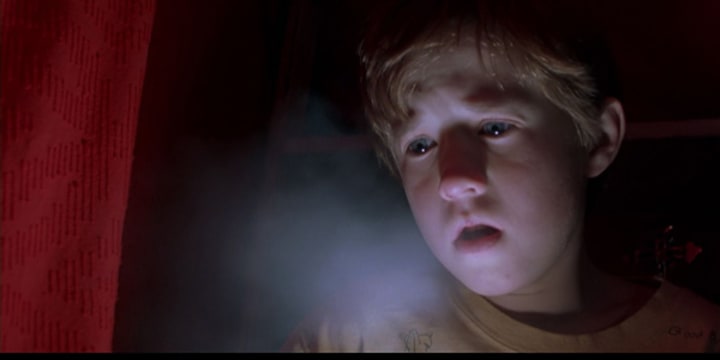
A Still from "The Sixth Sense"
This frame is very important for concentrating on temperature as you can see there is an amount of cold created. Now, let's delve into why it is this greyish hue that creates the cold atmosphere. Of course, cold air comes out white but on a black background looks grey.
If you were to tint this entire frame grey, you wouldn't get the same effect as having the character breathe cold air. The temperature change is very important as this is a symbol that will show when someone dead is near.
Here's a tip: Instead of changing the tone of the scene to something that's really dark; you may want to establish your scene as dark and then simply change the temperature. This way, it won't look as clogged up with tone changes.
Frame 6

A Still from "The Sixth Sense"
The temperature of your scene doesn't have to be done through darkness or cold air or even changing the hue of the scene; you could do it through weather. In this frame we don't actually see it raining, but we see that there is rain pattering on the glass of the window.
This is highly effective for changing the effect of the scene as now we have a pathetic fallacy that we can follow. This means that there may be something bad about to happen or something that may change the tone of the scene from fairly content to quite sad somewhere in this scene.
The way to do this isn't to establish the rain at the point of interest, but establish that there is rain beforehand. Maybe you could hear the sound of thunder or heavy rain from the inside of the house and, by the time the audience actually see it, there is something bad already known and felt.
Conclusions:
If you wanted to explore some more themes in the film The Sixth Sense then you could most obviously look at the following:
- Death
- Religion
- Helplessness
- Violence
- Children
I would heavily suggest the last one as I find it important that the start of The Sixth Sense is basically Malcolm's wake up call to fix the ending. The whole film revolves around children as there are many children that are helpless against the violence put on to them; the child under the bed with the video tape, the child with the back of his head missing etc. I hope you find these useful and have found this article easy to read and insightful. Good luck with your next project!
About the Creator
Annie Kapur
200K+ Reads on Vocal.
English Lecturer
🎓Literature & Writing (B.A)
🎓Film & Writing (M.A)
🎓Secondary English Education (PgDipEd) (QTS)
📍Birmingham, UK



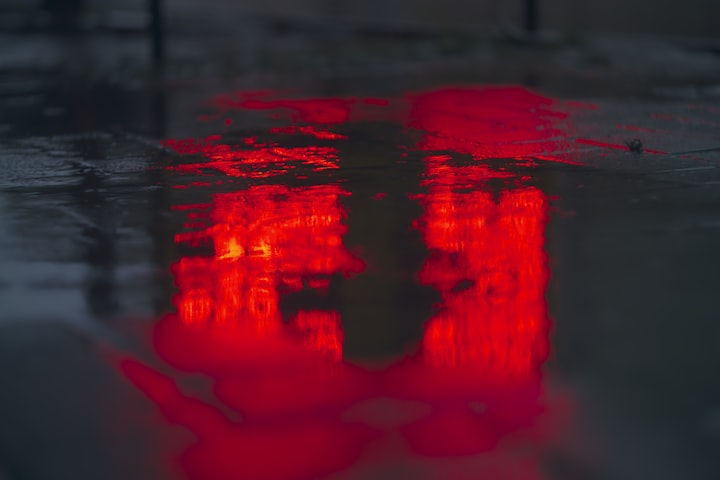

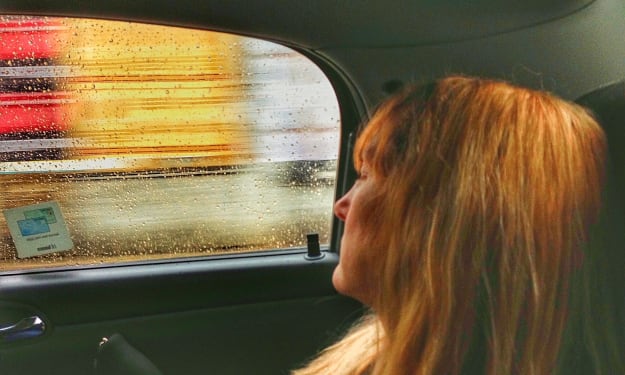
Comments
There are no comments for this story
Be the first to respond and start the conversation.